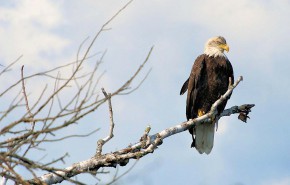Bird watchers around the world are helping power bird surveys used to protect rare, threatened, or endangered birds while clearing project work to proceed.
Before starting project work that involves clearing vegetation or other alterations to the natural landscape, state and federal regulations require us to make sure that we are not negatively impacting rare, threatened, or endangered (RTE) birds and other wildlife. The bird surveys we conduct to meet these regulations often utilize valuable information from a body of research called ‘citizen science’—a range of ‘crowd-sourced’ scientific data contributed by amateur and professional participants around the world.
Birders’ Field Observations Form a Worldwide Database
A web application called eBird compiles citizen science data about bird observations to create a powerful database that helps form a picture of bird presence in project areas. Coordinated jointly by the Cornell Laboratory of Ornithology and the National Audubon Society, eBird currently incorporates more than 100 million bird sightings from birders around the globe—making it the largest biodiversity-related citizen science project in the world. GAI’s environmental specialists regularly consult eBird before visiting a project area to conduct field bird surveys, and eBird data often comes into play throughout the survey process to help us form a final accurate assessment of bird presence.
The Curious Case of the Butcher Bird
eBird citizen science data for the Loggerhead Shrike played a significant role in formulating a reasonable conclusion for work to proceed on a transmission line rebuild project in Virginia. The Loggerhead Shrike is one of the U.S Fish and Wildlife Service’s Birds of Conservation Concern; its numbers in the U.S. have declined significantly in recent years, particularly in the Midwest, New England, and Mid-Atlantic regions.
![]()
A small predatory bird, the Loggerhead Shrike differs from true birds of prey in its lack of strong talons used to kill and hold prey securely while it is consumed. To make up for this, the Loggerhead Shrike has developed the behavior of catching then impaling prey on pointed objects like thorns, sharp twigs, or even barbed wire. The impalement kills the prey and steadies the carcass while the Loggerhead Shrike eats it. This signature behavior has earned the Loggerhead Shrike the nickname ‘Butcher Bird.’
Preliminary desktop analysis of the transmission line project site using eBird revealed multiple Loggerhead Shrike sightings in close proximity to the site within two years prior to the survey. On-site surveys for the species did not find any Loggerhead Shrikes in the area where prior observations had been recorded. However, the surveys did discover the mummified carcass of an unidentified bird impaled on a barbed wire fence, which supported eBird data that Loggerhead Shrikes had been in the area. This is where the combination of eBird’s citizen science data and our field analysis expertise came together to solve the case of the Butcher Bird.
Bird surveys are primarily concerned with protecting birds during their breeding season—this means that the surveys are formulated to determine a given bird’s presence or absence during the spring and summer months. Each nearby Loggerhead Shrike sighting presented by eBird was logged during non-breeding months, no nests were detected during on-site surveys, and the months-old impaled kill—the only on-site evidence to support Loggerhead Shrike presence—added up to suggest that Loggerhead Shrikes were present only during non-breeding months at this location.
Thus, the evidence collected during all phases of the survey supported the conclusion that the elusive Butcher Bird was ‘just passing through’ the project area during its cool-weather wanderings or is a local resident expanding its territory during the winter months. The GAI bird survey team presented this scenario to state regulators as part of its final bird survey report—the well-reasoned analysis was accepted, and work to rebuild the transmission line was cleared to proceed.
Pros and Amateurs Unite to Protect Vulnerable Birds
Providing a powerful tool for performing aspects of our environmental work, the wide-ranging volume of reliable data that citizen science places at our disposal is an exciting outcome of an interconnected world. eBird is a vivid illustration of how the contributions of engaged amateurs—compiled, vetted, curated by trained specialists—can play a consequential role in real-world decisions and help us take steps to protect rare, threatened, and endangered species.
eBird is a vivid illustration of how the contributions of engaged amateurs can play a consequential role in real-world decisions and help us take steps to protect rare, threatened, and endangered species.
Contact GAI Assistant Environmental Manager Matthew White, 317.436.4832, for more information about bird surveys and other GAI services that help conserve wildlife while being sensitive to project need.
![]() Assistant Environmental Manager Matthew White, MS specializes in environmental permitting and compliance; wetland delineations and stream identifications; on-site and desktop siting of linear and non-linear projects; and rare, threatened, and endangered (RTE) species consultations, particularly habitat and presence/absence surveys for birds.
Assistant Environmental Manager Matthew White, MS specializes in environmental permitting and compliance; wetland delineations and stream identifications; on-site and desktop siting of linear and non-linear projects; and rare, threatened, and endangered (RTE) species consultations, particularly habitat and presence/absence surveys for birds.


